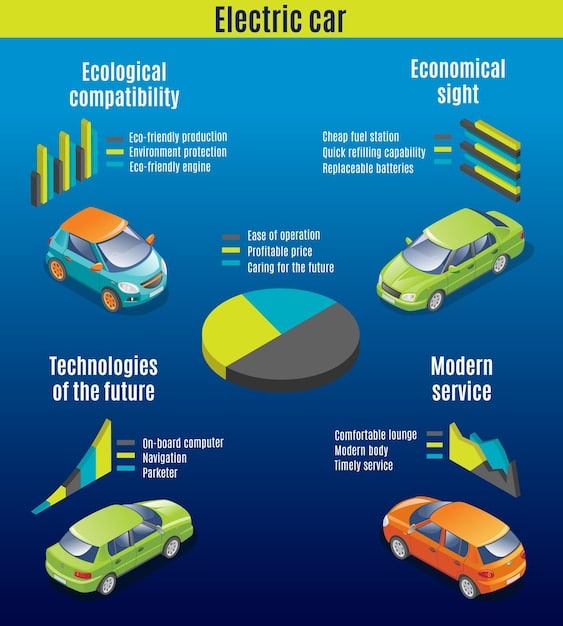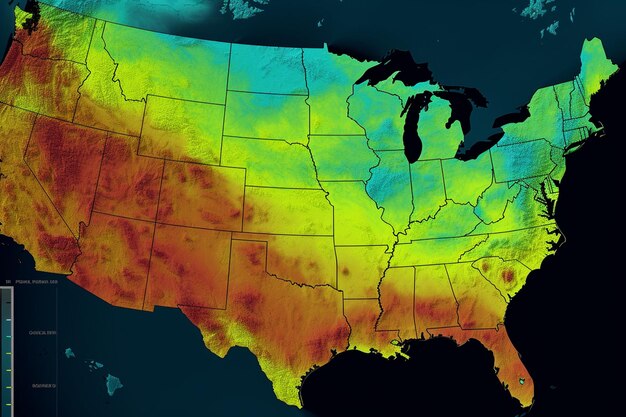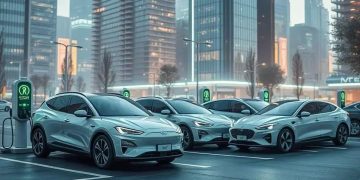US Electric Vehicle Market Share: Latest Sales Figures and Market Trends

US Electric Vehicle Market Share: What Do the Latest Sales Figures Reveal? The latest sales figures indicate a growing adoption of electric vehicles (EVs) in the US market, influenced by factors like government incentives, technological advancements, and increasing consumer awareness of environmental concerns.
The **US Electric Vehicle Market Share: What Do the Latest Sales Figures Reveal?** They paint a picture of an industry on the cusp of significant transformation, driven by innovation, policy, and evolving consumer preferences. Let’s delve deeper into the numbers and what they signify for the future of transportation.
Understanding the Current US EV Market Landscape
The electric vehicle (EV) market in the United States is undergoing a period of rapid evolution. To fully grasp the significance of recent sales figures, it’s essential to understand the present state of the industry, including major players, infrastructure developments, and policy influences.
Key Players in the US EV Market
Several companies are leading the charge in the US EV market, each with its own unique strengths and strategies.
- Tesla: Remains the dominant player, holding a significant portion of the market share with its Model 3, Model Y, and other vehicles.
- General Motors (GM): Is aggressively investing in electrification, with plans to launch numerous EV models across various segments.
- Ford: Has made significant strides with its Mustang Mach-E and F-150 Lightning, demonstrating a commitment to electric vehicles.
- Rivian: Is a newcomer making waves with its electric pickup trucks and SUVs, targeting the adventure and outdoor recreation markets.

Beyond these major players, numerous other companies are entering the EV market, offering diverse options and fostering competition. Government policies and technological advancements play a crucial role in shaping this dynamic landscape.
Policy and Infrastructure Influences on EV Adoption
Government policies and the development of charging infrastructure are pivotal in driving the adoption of electric vehicles in the US. Incentives, regulations, and support for infrastructure projects significantly affect consumer behavior and market growth.
Federal and State Incentives for EV Purchases
Both the federal government and individual states offer various incentives to encourage EV adoption.
- Federal Tax Credits: Provide a tax credit for eligible EV purchases, reducing the initial cost for consumers.
- State Rebates and Grants: Many states offer additional rebates or grants, further lowering the price of EVs.
- HOV Lane Access: Some states allow EVs to use high-occupancy vehicle (HOV) lanes, incentivizing their use in urban areas.
These incentives not only make EVs more affordable but also highlight the benefits of owning and operating an electric vehicle.
Charging Infrastructure Development
The availability of convenient and reliable charging infrastructure is crucial for widespread EV adoption.
- Public Charging Stations: The number of public charging stations is growing, with investments from both government and private sectors.
- Home Charging Solutions: Many EV owners install home charging units, providing convenient overnight charging.
- Fast Charging Technology: Advancements in fast charging technology are reducing charging times, making EVs more practical for long trips.
The expansion of charging infrastructure addresses range anxiety and makes EV ownership more appealing to a broader audience.
Diving into the Latest EV Sales Figures
Recent sales figures provide valuable insights into the trends shaping the US EV market. Analyzing these numbers reveals patterns in consumer preferences, regional adoption rates, and the overall health of the industry.
Overall EV Sales Trends
The data indicate a steady increase in EV sales in the US, reflecting growing consumer interest and acceptance.
- Year-over-Year Growth: EV sales have consistently grown year-over-year, indicating a sustained upward trend.
- Market Penetration: The percentage of EVs in overall vehicle sales is increasing, signifying a shift in consumer preferences.
- Regional Disparities: EV adoption rates vary across different regions, influenced by factors such as local incentives and infrastructure availability.

These trends suggest that the EV market is maturing, with more consumers considering electric vehicles as a viable option.
Popular EV Models and Their Performance
Certain EV models are particularly popular among US consumers, driving a significant portion of the market share.
- Tesla Model Y and Model 3: Continue to be top sellers, benefiting from Tesla’s brand recognition and established charging network.
- Ford Mustang Mach-E: Has gained traction as a performance-oriented electric SUV, appealing to a different segment of buyers.
- Chevrolet Bolt: Offers an affordable entry point into the EV market, attracting budget-conscious consumers.
The success of these models highlights the importance of performance, range, and price in driving EV sales.
Factors Driving the Increased EV Market Share
Several factors contribute to the growing market share of electric vehicles in the US, ranging from technological advancements to environmental concerns and economic considerations.
Technological Advances in EV Technology
Ongoing advancements in EV technology are enhancing performance, range, and efficiency, making electric vehicles more competitive with traditional gasoline-powered cars.
Advancements in battery technology extend the range of EVs, alleviating range anxiety and enabling longer trips. Improvements in motor efficiency and aerodynamics enhance overall performance and energy consumption. The integration of advanced driver-assistance systems (ADAS) and connectivity features adds to the appeal of electric vehicles.
Environmental Awareness and Sustainability
Increasing environmental awareness and a desire for sustainable transportation options are driving consumers to consider electric vehicles.
Consumers are increasingly concerned about the environmental impact of gasoline-powered vehicles and are seeking cleaner alternatives. Electric vehicles produce zero tailpipe emissions, reducing air pollution and contributing to a healthier environment. The use of renewable energy sources to power EVs further reduces their carbon footprint and promotes sustainability.
Government incentives and policies that support EV adoption reinforce the environmental benefits of electric vehicles.
Economic Benefits of EV Ownership
The economic benefits of owning an electric vehicle, such as lower fuel and maintenance costs, are attracting more consumers.
Electric vehicles have lower fuel costs compared to gasoline-powered cars, as electricity is typically cheaper than gasoline. Reduced maintenance requirements, such as fewer oil changes and tune-ups, contribute to lower ownership costs. Government incentives and tax credits further enhance the economic advantages of EV ownership. Over the long term, these factors can result in significant cost savings for EV owners.
Challenges and Opportunities in the US EV Market
Despite the positive trends, the US EV market faces several challenges that need to be addressed to achieve widespread adoption. These challenges also present opportunities for innovation and growth.
Addressing Range Anxiety and Charging Infrastructure Gaps
Range anxiety, the fear of running out of battery power, remains a significant concern for potential EV buyers.
Expanding charging infrastructure, particularly in rural areas, is essential to alleviate range anxiety and support long-distance travel. Investing in fast charging technology can reduce charging times and make EVs more convenient for daily use. Educating consumers about the actual range capabilities of EVs and the availability of charging options can help dispel misconceptions and build confidence.
Public-private partnerships can accelerate the deployment of charging infrastructure and ensure its accessibility to all EV owners.
Reducing EV Production Costs
The higher initial cost of electric vehicles compared to gasoline-powered cars is a barrier to entry for many consumers.
Innovations in battery technology and manufacturing processes can reduce production costs and make EVs more affordable. Economies of scale, as production volumes increase, can further drive down prices. Government incentives and subsidies can help offset the higher upfront costs and make EVs more accessible to a broader range of consumers.
Standardizing battery designs and charging infrastructure can also help reduce costs and promote wider adoption.
Ensuring a Sustainable EV Supply Chain
Ensuring a sustainable and ethical supply chain for EV components, particularly batteries, is crucial for the long-term viability of the industry.
Sourcing battery materials from responsible and ethical suppliers can minimize environmental and social impacts. Investing in battery recycling technologies can reduce the demand for raw materials and promote a circular economy. Establishing transparent and traceable supply chains can ensure that EV components are produced in an environmentally and socially responsible manner.
Future Outlook for the US EV Market
The future of the US EV market looks promising, with continued growth and innovation expected in the coming years. Several factors will shape the trajectory of the industry and determine its ultimate success.
Continued advancements in battery technology will extend the range of EVs and reduce charging times, further enhancing their appeal. The expansion of charging infrastructure will alleviate range anxiety and make EVs more practical for long-distance travel. Favorable government policies and incentives will continue to drive EV adoption and support the growth of the industry. As consumer awareness increases and more EV models become available, the market share of electric vehicles is expected to rise significantly.
| Key Point | Brief Description |
|---|---|
| ⚡ EV Sales Growth | Consistent increase in EV sales year-over-year in the US. |
| 🔋 Battery Tech | Advancements improving EV range and efficiency. |
| 💰 Incentives | Federal and state incentives driving EV adoption. |
| 🌍 Environmental Awareness | Growing concern for sustainability boosting EV demand. |
FAQ: US Electric Vehicle Market Share
▼
The market share of EVs in the US is steadily increasing, accounting for a growing percentage of overall vehicle sales each year. Recent data indicates a significant rise compared to previous years.
▼
Tesla’s Model Y and Model 3 are consistently among the best-selling EVs in the US. Other popular models include the Ford Mustang Mach-E and the Chevrolet Bolt due to their performance and affordability.
▼
Several factors are driving growth, including technological advancements in battery technology, growing environmental awareness, government incentives, and the long-term economic benefits of EV ownership.
▼
Challenges include addressing range anxiety and charging infrastructure gaps, reducing EV production costs to make them more affordable, and ensuring a sustainable and ethical supply chain for EV components.
▼
The future looks promising, with continued growth and innovation expected. Continued advancements in battery technology, expanded charging infrastructure, and supportive government policies are key factors.
Conclusion
The **US Electric Vehicle Market Share: What Do the Latest Sales Figures Reveal?** It is a dynamic and evolving landscape, poised for continued growth and transformation. As technology advances, infrastructure expands, and consumer awareness increases, electric vehicles are set to play an increasingly important role in the future of transportation.





